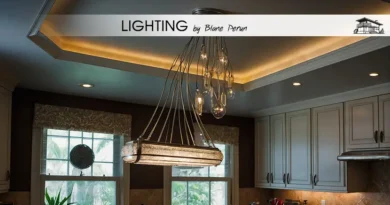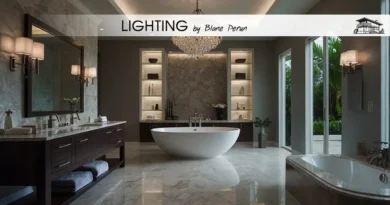Lighting
Illuminating Insights: Navigating the World of Interior Lighting Design
When it comes to setting the mood and enhancing the aesthetics of a space, few elements are as pivotal as interior lighting design. This artful blend of science and creativity not only illuminates our living spaces but also significantly impacts our mood, productivity, and overall perception of an environment. Delving into the realm of interior lighting design opens up a world of possibilities, from the warm glow of ambient lighting to the precision of task lighting, each carefully chosen fixture and bulb plays a crucial role in creating the perfect ambiance.

The Foundation of Effective Lighting
Understanding the Spectrum: The Role of Color Temperature
Diving into the nuances of interior lighting design, one cannot overlook the importance of color temperature, measured in Kelvin (K). This scientific measure affects the warmth or coolness of light, significantly influencing the atmosphere of a room. A lower Kelvin rating emits a warmer, more inviting glow, ideal for living rooms and bedrooms, where comfort is key. Conversely, higher Kelvin lights provide a cooler, more alerting light, suited for offices and kitchens where focus and visibility are paramount.
Layering Lights: Creating Depth and Dimension
A fundamental principle in interior lighting design is the concept of layering, which involves integrating ambient, task, and accent lighting to achieve a balanced and functional space. Ambient lighting serves as the foundation, providing overall illumination. Task lighting, as the name suggests, is focused on specific areas to facilitate activities like reading or cooking. Accent lighting, the final layer, highlights architectural features or artwork, adding depth and drama to the space. Mastering this trio can transform any room from mundane to magnificent.
Innovations in Lighting Technology
LED Advancements: Brightening the Future
In recent years, Light Emitting Diodes (LED) technology has revolutionized interior lighting design. LEDs offer unparalleled energy efficiency, longevity, and versatility, allowing for a broad spectrum of color temperatures and design possibilities. This innovation aligns with the scientific term “luminous efficacy,” which measures how well a light source produces visible light, a key factor in sustainable design practices.
Smart Lighting: Personalization at Your Fingertips
The advent of smart lighting systems has introduced a new layer of convenience and customization to interior lighting design. These systems allow users to control the intensity, color, and even the direction of light with the touch of a button or a voice command. The integration of IoT (Internet of Things) in lighting design exemplifies the convergence of technology and aesthetics, offering a personalized lighting experience that can adapt to the user’s lifestyle and preferences.
The Art of Choosing the Right Fixtures
The Statement Piece: Chandeliers and Pendant Lights
Selecting the right fixtures is crucial in interior lighting design, with chandeliers and pendant lights often serving as the centerpiece of a room. These fixtures not only provide essential illumination but also act as a focal point, reflecting the room’s style and personality. From the ornate intricacies of a classic chandelier to the sleek minimalism of a modern pendant, the choice of fixture can dramatically alter the room’s ambiance.
Functional Aesthetics: Recessed and Track Lighting
For those seeking a more understated approach, recessed and track lighting offer a blend of functionality and aesthetics. Recessed lighting provides a clean, streamlined look, ideal for contemporary spaces, while track lighting offers flexibility, allowing individual lights to be directed where needed most. These options exemplify the principle of “form follows function,” ensuring that lighting is not only beautiful but also serves its intended purpose effectively.
In the dynamic field of interior lighting design, blending scientific understanding with creative expression leads to spaces that are not only visually appealing but also harmoniously balanced and functionally sound. The careful selection of color temperatures, innovative technologies, and striking fixtures can transform any space, making interior lighting design a key element in the architectural and design industries.

FAQs on Interior Lighting Design
What is the best color temperature for a cozy living room ambiance?
For a cozy living room ambiance, lighting with a lower color temperature, typically around 2700K to 3000K, is ideal. This range emits a warm, soft glow reminiscent of sunset, creating a relaxing and welcoming atmosphere, perfect for unwinding after a long day.
How can I use lighting to make a small room appear larger?
Strategic use of lighting can make a small room appear more spacious. Utilizing brighter, uniform ambient lighting to minimize shadows and dark corners can visually expand the space. Mirrors and reflective surfaces can also amplify light, further enhancing the sense of openness.
What are the benefits of incorporating LED lights in interior design?
LED lights offer several benefits in interior design, including energy efficiency, longevity, and a wide range of color temperatures. They produce less heat, reducing cooling costs, and their compact size allows for innovative and flexible design solutions. LEDs also offer dimmable options, providing versatility in creating different moods and atmospheres within a space.
Can smart lighting systems contribute to energy savings in a home?
Absolutely, smart lighting systems can significantly contribute to energy savings in a home. These systems allow for precise control over lighting levels and can be programmed to turn lights off automatically when a room is unoccupied. Additionally, the ability to adjust lighting based on natural light availability or specific times of the day can further optimize energy use, ensuring that lights are on only when needed and at the most efficient levels.
What is the importance of layering in interior lighting design?
Layering in interior lighting design is essential for creating a versatile and functional space. It involves combining different types of lighting—ambient, task, and accent—to enhance the room’s functionality and aesthetic appeal. Ambient lighting provides overall illumination, task lighting focuses on specific areas for activities like reading or cooking, and accent lighting highlights architectural features or artwork. This approach allows for flexibility in setting the mood and atmosphere of a room, ensuring that it can adapt to various needs and occasions.
By weaving together the technical aspects of lighting, such as color temperature and luminous efficacy, with the artful selection of fixtures and innovative technologies like LED and smart systems, interior lighting design transcends mere functionality. It becomes an integral part of our daily lives, shaping our environments in ways that enhance our well-being and reflect our personal styles. In the constantly evolving field of interior lighting design, staying informed and imaginative can illuminate endless possibilities, transforming ordinary spaces into extraordinary experiences.





